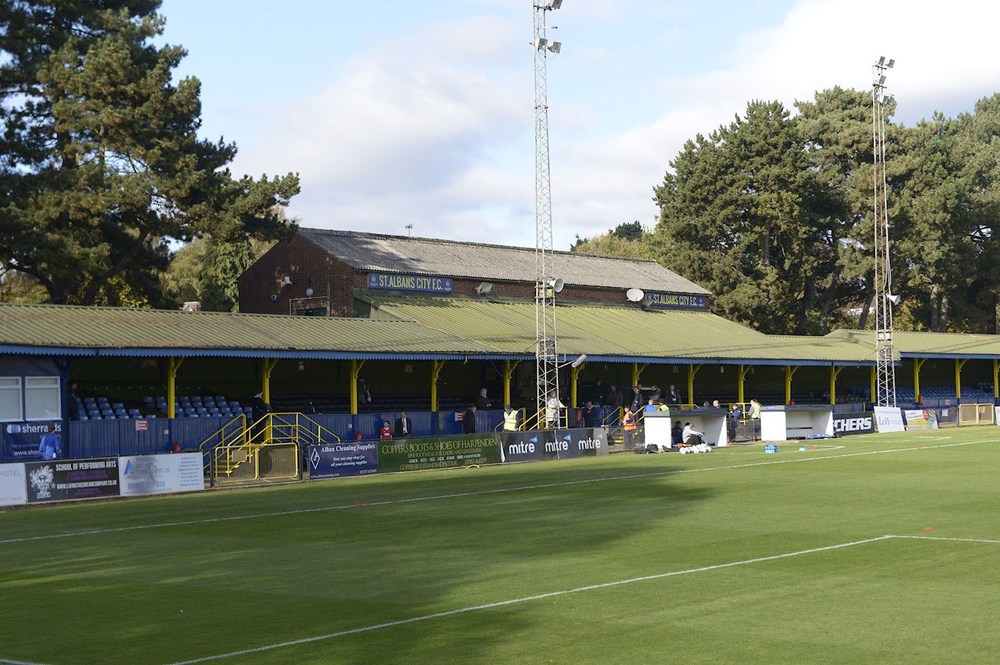
St Albans City`s Clarence Park
St Albans City was founded in April 1908 but the golden period in the club`s history came during the 1920s.
Football had been played at the Saints` Clarence Park home for 14 years prior to the formation of the present-day club.
The original St Albans, which also played home matches at three other venues within the old Roman stronghold in the Southern League, met its demise in 1904 having come into existence back in 1881.
After a four-year lapse, a senior club bearing the name of the city rose again in 1908 and during its formative years competed in the Herts County and Spartan Leagues.
A move to the Athenian League in 1920 heralded the start of the Saints halcyon days as that championship was won twice in three years paving the way for election to the Isthmian League.
City won the Isthmian League at the first attempt and followed it with two further successes before the decade was out.
City remained in the Isthmian League until 2003 but never again did the title return to Clarence Park.
Amazingly, despite finishing just three points clear of relegation in 2003/04, the Saints secured a place in the Conference South, from the Isthmian League, on the back of remarkable 4-3 and 5-4 play-off victories at Heybridge Swifts and Bedford Town respectively.
Midway through the following campaign, City were rooted to the foot of the table and facing an immediate return to the Isthmian League.
Their fortunes changed with the appointment of the experienced Colin Lippiatt, assistant manager to Geoff Chapple during Woking’s numerous successes during the 1980s, who moulded a struggling outfit into an attack-minded one that rose to the safety of 14th place.
The 2005/06 Conference South season kicked off with two consecutive defeats before Lippiatt’s side found their rhythm and ultimately pushed Weymouth for the championship right to the final week of the season.
City, scorers of 14 goals more than the second-highest scoring team in the division, had to settle for second place but successfully claimed a place in the Conference National by overcoming Histon in the play-off final in front of a crowd of 3,175 at Stevenage.
City’s stay in the Conference National proved to be short-lived and after just one season the club has returned to Conference South.
The 2007/08 campaign saw the Saints on course for a second successive relegation as two managers, Ritchie Hanlon and then Dave Anderson, were dismissed within the first six months of the season.
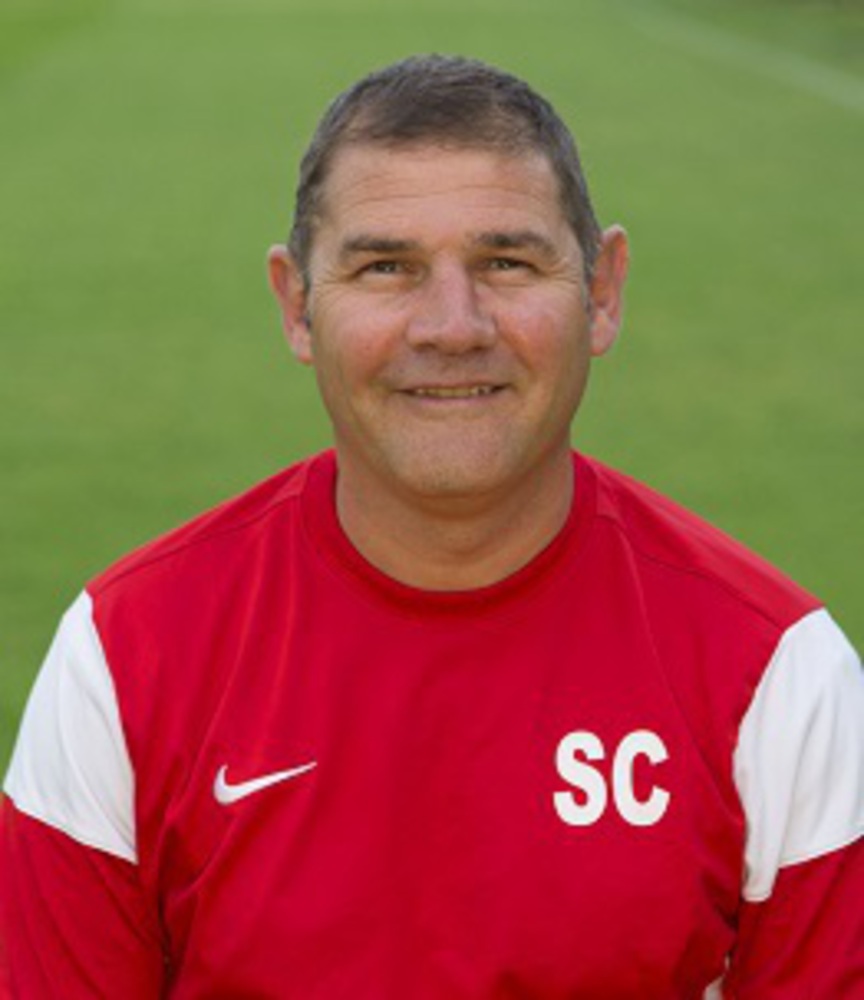
Steve Castle
Former Saints boss and current Royston Town manager, Steve Castle, returned in January but it was only with the return for a second spell of goalkeeper Paul Bastock that City’s fortunes improved dramatically with relegation avoided during the final week of the season.
Castle won the Conference South manager of the month award for March while Bastock, after his first six games, collected the Conference South player of the month award.
The 2008/09 season saw the club in calmer waters as they finished in a safe twelfth position but had a poor time in all of the cup competitions.
In the summer of 2009, it was announced that chairman John Gibson's building firm, William Verry, were to go into administration with debts mounting continuously.
Gibson himself released a statement with regards to the club's future, stating that it was safe and in the month that followed he released another statement regarding the club's finances.
Following this statement, there were rumours of buy-outs by a rival building firm who had taken on a number of William Verry's contracts. This apparently was unfounded.
The summer of 2010 went somewhat smoother for the Saints, as the financial worries that had plagued the team in 2009 had, thankfully, not returned, and Steve Castle was able to get on with assembling his squad for the new season, albeit with one of the smallest budgets in the league.
In February 2011, the FA fined St Albans £7,500 and deducted 10 league points.
The punishment was handed down to City chairman John Gibson and then vice-chairman Alasdair McMillin during a Regulatory Hearing at the Association's offices at Wembley and was in relation to alleged illegal payments to players, described by the FA as financial irregularities, by the club during the 2008/09 season. The Saints appealed, but the original decision was upheld.
Therefore, St Albans were relegated after losing 4–0 to Ebbsfleet United and were informed they would play in the Southern League Premier Division in season 2011/12.
In June 2011, manager Steve Castle was released, and, after many weeks of speculation, his successor was announced as being former Enfield and England semi-professional international David Howell, who had recently taken Harrow Borough to the play-offs in the Isthmian Premier Division.
Now playing in the Southern League Premier Division for the first time in their history and at their lowest level for over 20 years, the Saints weren't considered one of the favourites for the division, although a late surge in late January and February took them to the brink of the play-offs. However, only one win in the final five games meant St Albans finished eighth.
Howell started the 2012/13 season with a much-improved budget and St Albans were among the favourites for the division, signing players like former Fulham striker Barry Hayles.
But, despite starting the season well, a slump in October and November which also saw early exits in the FA Cup and FA Trophy saw Howell sacked and youth team coaches James Gray and Graham Golds take over, initially as a caretaker management team.
However, the performances improved with some better football, and they were given the job full-time. But several players left over the Christmas period and the owners introduced a controversial decision to up the admission prices mid-season - St Albans finished eleventh.
The 2013/14 season was a major success with pre-season signings of the calibre of ex-Hitchin Town favourite John Frendo, who was the league's top scorer the previous season.
After an indifferent start that saw St Albans lose four games up to the end of September, it was the arrival of Rambir Marwa in midfield that saw a change in fortunes.
St Albans made the FA Cup First Round for the first time since 2002, losing 8–1 at home to Mansfield Town in front of over 3,000 supporters.
A new record of away wins without defeat was also set – sixteen - and St Albans finished the season fourth and won the play-offs, defeating Chesham United 3–1 in the final in front of 2,900 fans to return to the National League South where they have remained, finishing eighth and ninth respectively in 2017/18 and 2018/19.
Soham Town Rangers were formed in 1947 because of a merger between Soham Rangers (formed 1919) and Soham Town (formed 1920).
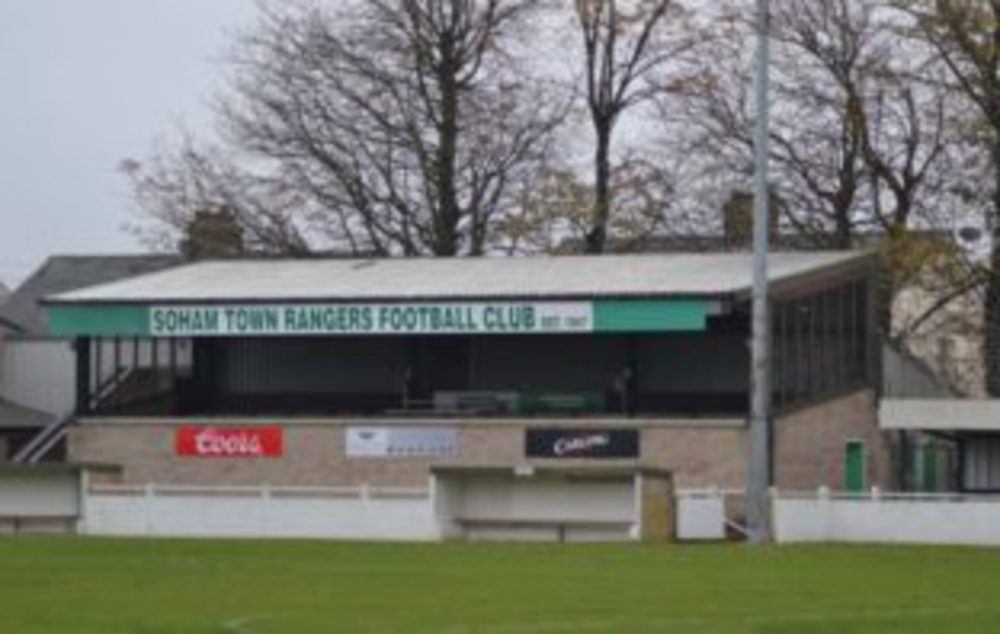
Soham Town Rangers` Julius Martin Lane
The Julius Martin Lane ground, which at the time was the home of Soham Town, is still the home of the club today after it was purchased in 1952.
The new club started life in the Cambridgeshire League, also running, then in 1956, they joined the Peterborough League where they were to remain until 1963.
During their time there, they won the league and the league cup on three separate occasions.
A measure of the level of support enjoyed by non-League clubs in those days was the fact that on their first home game of the season in August 22nd, 1956, a local derby against near-neighbors Ely City, over 500 programmes were sold! Unfortunately, the 6-2 drubbing for the hosts took the shine off the day.
The club joined the Eastern Counties League in 1963 and remained there until 2008.
The 2007/08 season was to be the club`s most successful season to date, winning the Eastern Counties Premier Division for the first time, beating nearest challengers Needham Market 4-0 on the final day of the season to clinch the title in front of 680 spectators at Julius Martin Lane, and with it promotion to the Southern League for the first time in their history.
In the first three seasons in the Southern League, Soham recorded finishes of 15th, 11th and 17th and at the end of the 2010/11 campaign, former Peterborough United, Northampton Town and Southend United striker Ian Benjamin, who had been at the club for six seasons and was in charge of the 2008 title winning side, stepped down from his position as manager.
Soham transferred to the Isthmian League Division One North for the 2011/12 season. However, with the Greens languishing near the foot of the table, new boss Andy Furnell was replaced by former Histon managers Steve Fallon and Ian Hart in March, with the club finishing the season fourth-from-bottom.
Since then, they have remained in the Isthmian Division One North, with seventh and eighth-place finishes in 2012/13 and 2013/14 being their best to date.
For many years, it was thought that Spalding United was formed in 1921, but recent research into club history has revealed that in fact, its existence goes back much earlier!
A chance sighting of an early team photograph on social media prompted some investigation and evidence gained shows that the club was formed back in 1905 following the amalgamation of the Fulney Institute and Victoria`s clubs was confirmed at a meeting in a local hostelry when it was decided that the name should be Spalding United.
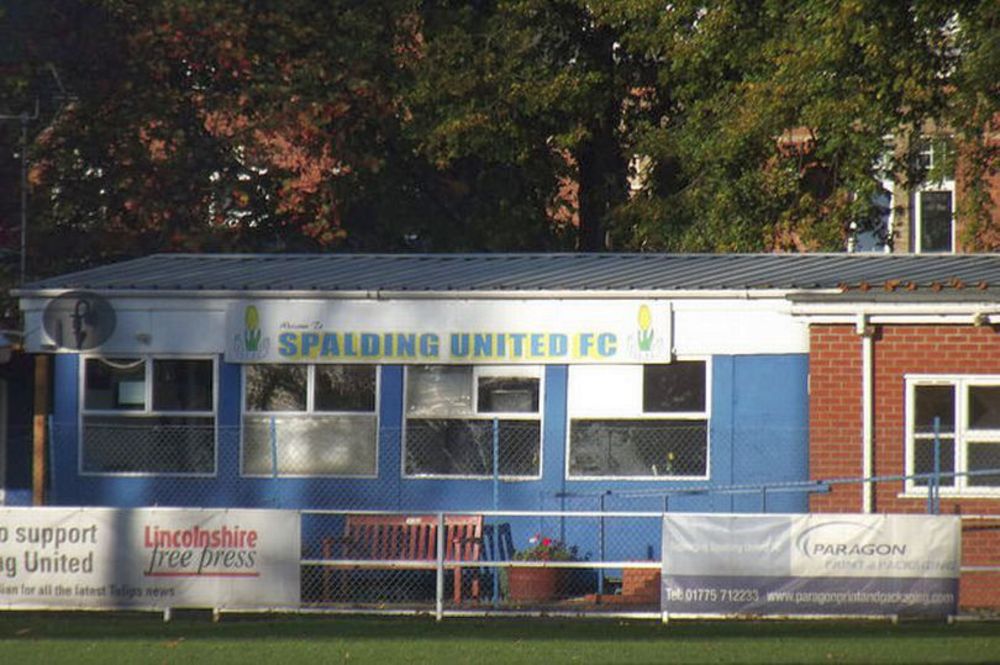
Spalding, nicknamed 'the Tulips' because of the town’s association with the bulb growing industry, played in the Spalding & District League but progressed to the Peterborough League.
Their first honours came in 1933 when they won the Lincolnshire Junior Cup. The feat was repeated in 1938 and they progressed to senior level and won the Lincolnshire Senior B Cup in 1951.
Further progress followed with success in the Lincolnshire Senior A Cup in 1953.
In 1952, the Tulips recorded their record ground attendance when playing Peterborough United - then a Midland League side - in a Second Qualifying Round of the FA Cup.
A crowd of 6,973 packed into the ground and saw Spalding leading 2-0 with 10 minutes to play but Posh fought back to equalise and went on to win the replay 3-0.
The club has reached the First Round of the FA Cup on two occasions - in 1957/58 when they lost 3-1 to Durham City and in 1964/65 when they played Football League opposition for the first time, being beaten 5-3 in a thrilling encounter at Newport County.
Spalding became United Counties League champions for the first time in 1955, having been runners-up in 1951, 1952 and 1953.
They then joined the Eastern Counties League but were without success and subsequently joined the Central Alliance League.
They stayed just one season before transferring to the re-formed Midland League in 1961 but again, no honours came their way and in 1968 they re-joined the United Counties League and won the title for a second time in 1975.
The Tulips changed competitions once more in 1982, joining the Northern Counties East League.
They were champions in 1984 but again returned to the United Counties League in 1986 when a third title was won two years later in 1987/88, a season which also saw them lift the Lincolnshire Senior Cup.
This time their success earned promotion to the Southern League and their first two seasons in the Midland Division saw them finish eighth and sixth in the table.
In 1989/90 Spalding enjoyed an excellent run in the FA Vase, defeating Knowle Town, Stamford after a replay, Harrisons, Lye Town, Bourne Town, also after a replay, and Great Yarmouth.
This earned them a home quarter-final tie with Guiseley, who included former Leicester City and England striker Frank Worthington in their side.
A crowd of 2,020 saw Guiseley win 3-1 after extra-time, having equalised in stoppage time.
Things took a down-turn with relegation back to the United Counties League the following season.
The club went into decline, and it took a number of years before they started to rebuild.
The recovery followed the appointment of Alan Day as manager in 1994 as Spalding won the League Knockout Cup in 1995, and in 1997 they were runners-up in the league as well as reaching the last sixteen of the FA Vase when Taunton Town defeated them.
In 1998 they finished third in the league and again reached the quarter-final stage of the Vase, losing narrowly 2-1 at home to eventual winners Tiverton Town in front of a crowd of 2,038.
In 1998/99 the club won the United Counties League championship, the Lincolnshire A Cup and the Hinchingbrooke Cup.
As UCL champions, Spalding regained membership of the Southern League and competed in the Eastern Division for the 1999/00 season.
Despite a disastrous period in the run-up to Christmas the club eventually finished the season in a creditable 15th position.
The following season saw the Tulips start well and for two weeks they were top of the table. But fortunes began to change following the departure of the manager and some of the players.
A new manager was appointed, and some new players drafted in, but by the end of the season the Tulips had slipped to bottom position. However, the expected relegation did not materalise as two other clubs – Baldock Town and Witney Town - resigned, giving the Tulips and Sittingbourne a reprieve.
The 2001/02 season saw Spalding start with quite a few new players, plus a new management set-up with Nick Andersen being assisted by Alex Irvine.
After getting off to a good start the team suffered a spate of injuries and again the club saw themselves at the foot of the table by the end of the season.
By hook or crook, they again somehow evaded relegation, but the club was in turmoil for the start of the next campaign with the chairman 'retiring' and leaving the club with no material successor.
However, co-manager Irvine took the initiative, stepping into the breach to ensure the club’s immediate future.
Possibly his best signing during his period in the chair was to get local businessman Chris Toynton to make a serious commitment to ensure the financial future of the club.
Irvine resigned at the end of the year shortly after the departure of manager Nick Andersen.
A procession of managers then followed with little or no success, doing little more than ensuring the club fulfilled its Southern League commitments.
The outcome was a return to the United Counties League. Following his success in leading neighbours Holbeach United to the United Counties League championship, their manager Dick Creasey became the target of new chairman Toynton. Creasey accepted the challenge of winning back-to-back championships with a different club.
At the start of the 2003/04 season, Toynton went public with his plan for the future of the club, the critical step being to win promotion from the United Counties League to benefit from the FA's re-organisation of the feeder leagues and this was the objective Dick Creasey accepted.
It was achieved on 8th May with a convincing 5-1 victory at Ford Sports, Daventry and to round off an excellent season the Tulips also won the East Anglian Cup for the first time in their history, beating Aveley 3-1 in the final.
The Tulips entered a new era by being placed in the Northern Premier League Division One.
After seeing his side lose a number of matches by a single goal, manager Dick Creasey resigned in early November 2004 and senior player Steve Charles took charge until a new manager could be appointed.
Charles, with more than 600 Football League appearances behind him, guided the side to an unbeaten spell of six matches before the arrival of Steve Welsh, another vastly experienced League player in England and Scotland.
The debut season in the NPL was one of highs and lows but too many defeats by a single goal resulted in the team finishing in 18th position but they ended the season on a high, however, by beating Lowestoft Town 4-2 to retain the East Anglian Cup.
Welsh resigned as manager to take up a full-time coaching role with Boston United in mid-October 2005 and was replaced by former Cambridge United legend, Alan Biley, who had more recently been assistant boss at Kettering Town.
Biley had immediate success, taking the team from bottom spot to mid-table within weeks of arriving. However, come early February 2006, Biley had returned to Kettering and ten days later former Lincoln City, Grimsby Town and Norwich City midfielder Phil Hubbard was named as his successor.
Hubbard guided the team out of the NPL relegation zone and to safety but an attempt to end the season on a high with a third successive East Anglian Cup victory failed with a narrow 1-0 defeat in the final to Harlow Town.
The 2006/07 season saw the Tulips return to the Southern League for a third time and finish 19th of 22 after a rollercoaster campaign.
But in the final phase of FA re-structuring, the club was re-located back to the Northern Premier League for the 2007/08 season, competing in Division One (South).
In mid-September 2007, Dominic Genovese took over the manager’s reins following the departure of Phil Hubbard after a dismal start to the season.
The hoped-for results failed to materialise, however, and a week into February 2008, Alan Biley, who had been released amid managerial changes at Corby Town, was enticed back to the Tulips for a third time as manager.
After successfully carrying out his remit to maintain Step 4 status, Biley departed again in June 2009.
After two weeks, former player Mark Hone was appointed to his first managerial position but resigned in mid-November with the team languishing in penultimate position in the league with just 9 points from 19 matches.
Assistant manager Richard Scott took temporary charge of the team and was appointed manager in mid-February, following an eight-match 'trial' period.
Sadly, his hopes of bringing success to the club did not materialise and with the team again in the relegation positions, Scott resigned in mid-January 2011 and this also signalled a mass exodus of players.
One positive note to recall from the 2011/12 season (the club's 90th Anniversary year) was a partnership deal struck with top local junior club, Spalding Athletic JFC which put Spalding United in close contact with age group football from the ages of under-8s to under-18s.
Andy Stanhope, who had enjoyed a lengthy playing career with the Tulips, stepped into the management breach together with another former player and manager, Bob Don-Duncan in late January 2011.
Unfortunately, they were unable to halt the slide and the team was eventually relegated back to the United Counties League.
After eleven months in charge, Stanhope was relieved of his duties and former Deeping Rangers boss, Pat Rayment, was appointed manager in January 2012.
Rayment, the ex-Cambridge United and Peterborough United full back, immediately set about restructuring the club and the beginning of the 2012/13 season saw a new management team in place, with former Peterborough player, Marcus Ebdon, joining as assistant manager and Bob Don-Duncan moving up to become director of football.
With the new management structure in place, a host of new and largely experienced players was encouraged to sign-up and join the `footballing revolution` about to take place at the Sir Halley Stewart Field.
At the end of the 2012/13 season, the Tulips narrowly missed out on promotion to Step 4 of the non-League Pyramid as they finished runners-up to St Ives Town, with some small consolation found when the Tulips lifted the UCL Knockout Cup in the final game of the season when they triumphed 4-0 over, ironically, St Ives!
Having suffered heartache on the final day of the 2013/14 campaign, losing out on promotion by a solitary point, Rayment and Ebdon were determined the side would hit the ground running from the outset of the new campaign.
The budget was stretched to secure such stellar signings as Nathan Stainfield, Jamie Stevens, Andy Tidswell, Lewis Webb and Jonny Allen and the Tulips duly cantered to the UCL Premier Division title, although success in any other cup was not forthcoming.
The 2014/15 campaign saw the Tulips back at Step 4 in the Northern Premier League First Division South where they have remained ever since, albeit with a couple of changes of division names.
Due to their geographical position, Spalding were always liable to be swapped around when the FA`s restructuring took place.
Hopefully for them, they may be able to settle down, assuming they are not moved again during this summer`s overhaul of the non-League Pyramid!
Staines Town have only had one season as a Southern League club in its 129-year history – and that came as recently as 2018/19.
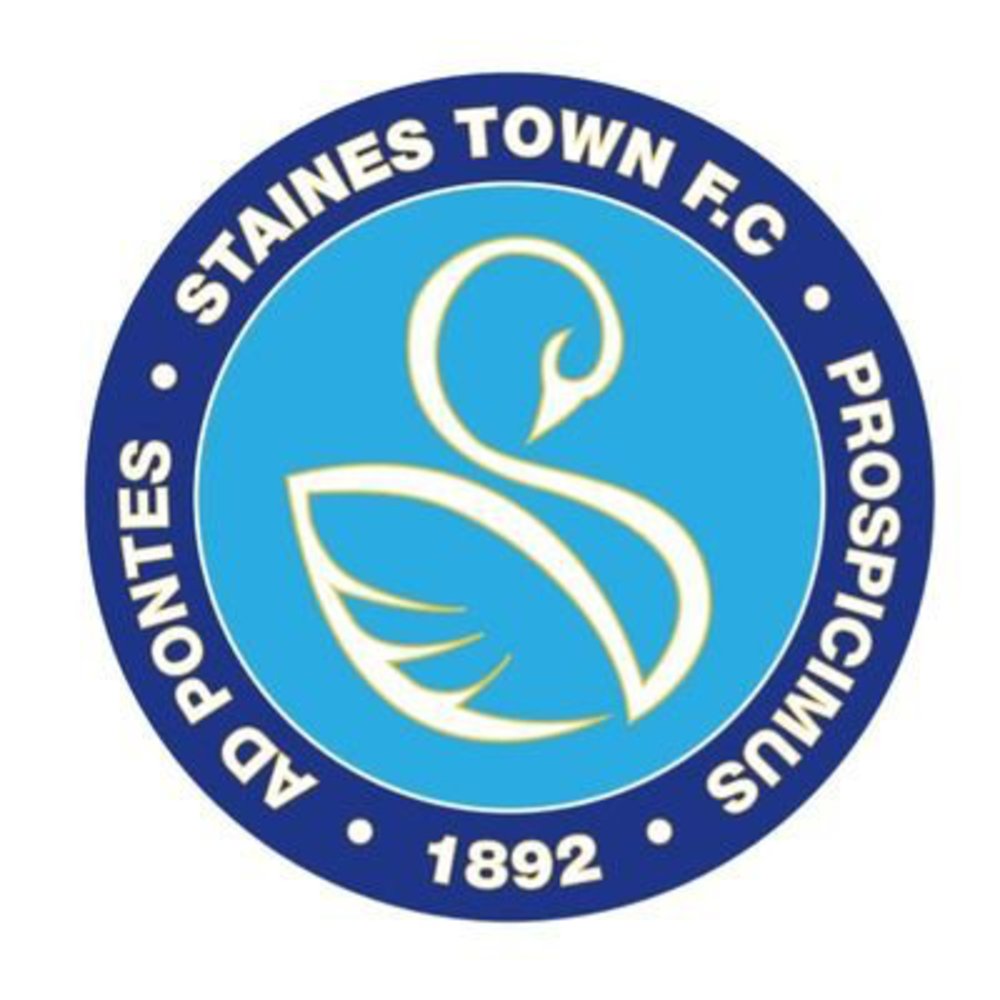
When Staines Town were formed in 1892, the club merged with St Peter’s Institute and the club went on to win local honours as both Staines FC and Staines Albany FC.
After several more name changes, the club began to go into decline and in 1935 folded. However, towards the end of the Second World War, the club re-formed as Staines Vale.
They then joined the Great Western Suburban League in 1905, later moving to the Great Western Combination.
In 1953, the Swans were founder members of the Hellenic League, where they finished runners-up in 1956.
In 1958 they joined the Spartan League and won the title two years later.
After finishing second in 1971, Staines advanced to the Athenian League, where they won the Second Division title at the first attempt, amassing a record number of points.
The club were elected to the new Isthmian League Division One in 1973 and in their second season, the club finished top and were promoted to the Premier Division.
In a nine-year stay, the club’s best finish was fourth, but a ground grading ruling meant that the club were demoted in 1984.
The club bounced back five years later only for its Premier Division status to be lost again in 1993 when the club were relegated for the first time in 63 years.
Again, the club were promoted in 1996 and again it was quickly lost, with the club returning to the Isthmian Division One after only a year.
Having lobbied Spelthorne Council for 20 years, planning permission for a £6.5m conference and health facility was granted in April 2000 and finalised a year later.
During construction, Staines ground shared with Walton & Hersham and Egham Town before the return to Wheatsheaf Lane (now shared with the Thames Club) in February 2003.
From season 2002/04, Staines played in Division One South of the Isthmian League and on the last day of season 2003/04, under Steve Cordery, they secured a place in the Premier Division in the newly re-structured Pyramid.
League success was enjoyed again under Steve Cordery when Staines finished runners-up in the Isthmian Premier two seasons running - the first occasion in 2007/08, the play-off final was reached and the club came within 8 minutes of promotion, finally succumbing to AFC Wimbledon.
However, just twelve months later, Carshalton Athletic were defeated in the final of the same competition to ensure the Swans entered the Conference for the first time in their history as promotion to Conference South was secured at Wheatsheaf Park.
They finished in a very creditable eighth place in their first season in the Conference South and were in the same spot at the end of the 2013/14 season.
However, the following campaign saw the Swans finish rock-bottom with just 25 points from 40 games and were relegated back to the Isthmian League.
They remained there until the summer of 2018 when they were switched by the FA to the newly formed Southern League Premier Division South, along with Harrow Borough, Hendon and Metropolitan Police from the Isthmian League.
But it proved a disaster for Staines as, at one stage, it looked as though they were going to compete with Woodford United for possessing the worst record in the league!
But they ended up with four wins from 42 matches but fell a massive 38 points adrift of the safety mark and conceded a whopping 168 goals!
So, it was definitely not a memorable campaign as a Southern League club and it was back to the Isthmian League in its South Central section!
Since 2018, Staines have been involved in a protracted and bitter dispute over the club`s land with a London-based investment firm.
The club`s current ownership has actively defended their position using its financial resources.
In December 2020, the club`s ownership group launched a multi-million-pound bid to buy out the investment firm - believed to be in the region of £2.5 million.
Team Bath started out in 1999 as the University of Bath`s football and education programme – one of the forerunners of the system that has boomed in recent years in colleges throughout the country.
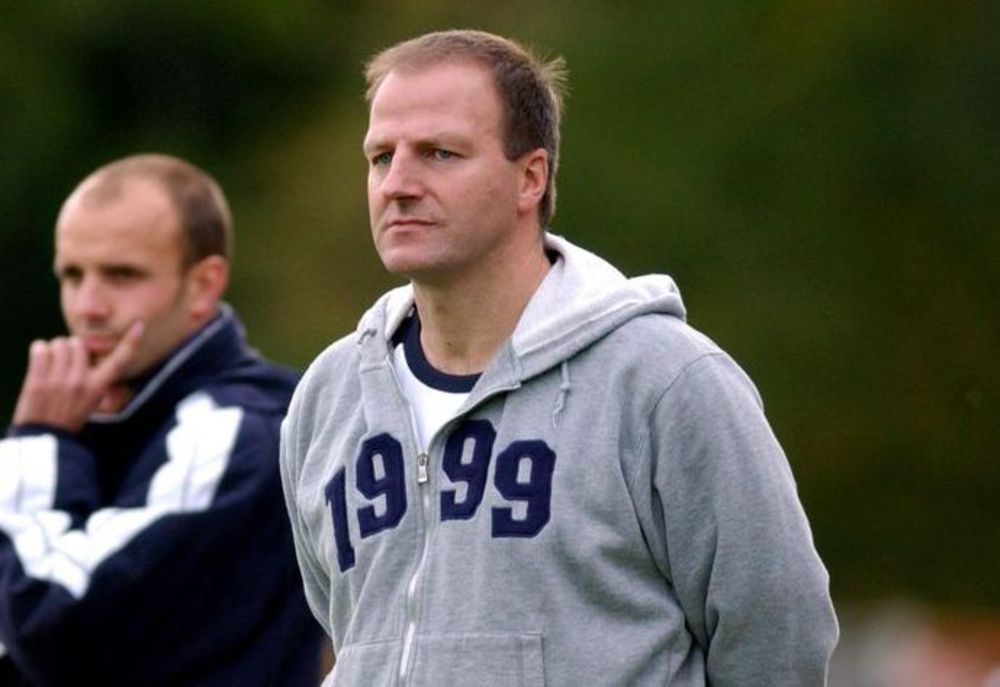
Ged Roddy
Under the University of Bath`s director of sport Ged Roddy, the team gained admittance to the Western League Division One in 2000/01 and won the title at the first attempt, scoring 108 goals and conceding just 22 in 36 matches.
Their first season in the Premier Division saw Team Bath finish a very creditable fourth behind Bideford AFC, Taunton Town and Brislington.
They also had their first crack at the FA Vase, reaching the Third Round before losing to Arlesey Town.
Whilst Roddy continued to be the manager, the more day-to-day and matchday coaching was being undertaken by former Southampton and Bristol City defender Paul Tisdale.
An injury forced him to end his career early, and he took a coaching role with Team Bath in 2000.
In the 2002/03 season, Team Bath won the Western League title by an eleven-point margin, scoring 109 goals along the way.
They also became the first university team to enter the FA Cup since Gonville & Caius in 1881.
Team Bath entered in the Preliminary Round stage and advanced through four qualifying rounds to the First Round Proper before losing to Mansfield Town in a game televised live on Sky.
Promoted to the Southern League Division One West, they finished a decent sixth in 2003/04 before the restructuring of the non-League Pyramid saw them pushed straight into the Premier Division the following season.
Team Bath finished 14th in their first season as a Premier Division side, also reaching the Third Round of the FA Trophy, and 17th the following season.
At the end of 2006/07, the club lost their influential head coach Paul Tisdale, who left to take over as manager of League Three side Exeter City, where he had a spell on loan towards the end of his time with Bristol City.
He went on to have a hugely successful twelve-year career in charge of the Grecians and then a slightly less happy time of it at MK Dons more recently.
Taking Tisdale`s role as head coach was defender Andy Tillson, who was already with the club as a player-coach.
Tillson started his career at Grimsby Town and then went on to play for Kettering Town, Queens Park Rangers, Bristol Rovers, Walsall and Rushden & Diamonds and made over 500 League appearances.
He joined Team Bath in 2003 as a player then as a coach.
Team Bath`s third season in the Southern League was a much more successful one as they finished runners-up to…..fierce rivals Bath City!
Team Bath now had to face the play-offs for the first time in their short history and they won their semi-final against Hemel Hempstead Town 3–1 and played Maidenhead United in the final.
Maidenhead, who had been relegated from the Conference South the season before, went on to win a hard-fought game 1–0, consigning Team Bath to another season in the Southern League.
In 2006/07, Bath City finished 12 points in front of their student neighbours, but in 2007/08, Team Bath again finished second, but this time had a real scrap for the title with King`s Lynn, who eventually pipped them by two points.
So, it was another crack at the play-offs for Roddy and Tillson`s side and a 4–1 victory against fifth-placed Bashley in the semi-final, aided by a hat-trick from the league's top scorer Sean Canham, saw Team Bath reach their second successive final.
This time they won it, beating the side who finished third, Halesowen Town, 2-1 with Canham grabbing a last-gasp winner to secure Team Bath a fifth promotion in just nine seasons!
In a strong Conference South, which was eventually won by AFC Wimbledon and also included the likes of Hampton & Richmond Borough, Bromley, Newport County, Eastleigh and Braintree Town, Team Bath finished a very creditable 11th.
However, the Football Conference ruled that the club could not, in its current format, win promotion to its Premier division – and hence on to the Football League.
So, it was the end of football in the non-League Pyramid for Team Bath, although they now, ironically, work alongside former rivals Bath City, giving the university`s top players the opportunity to feed into City’s under-21 development squad and first team.
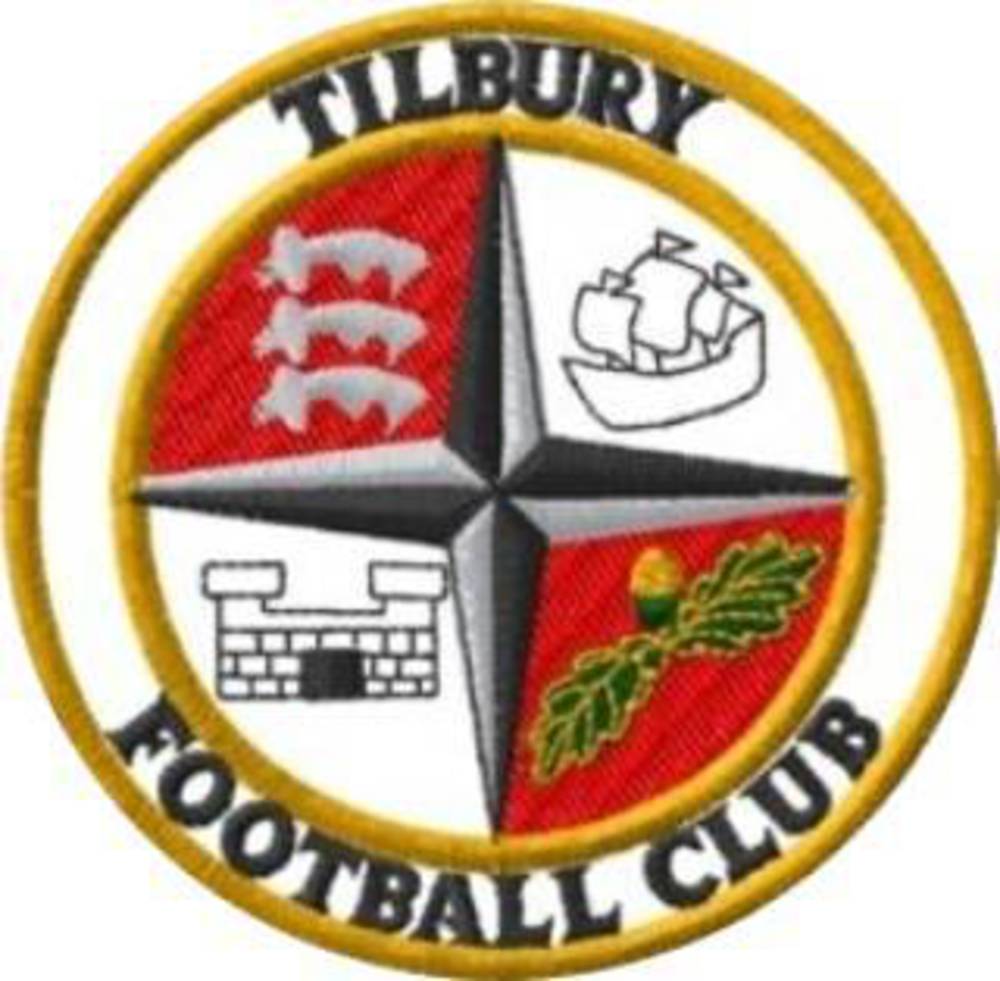
Like Staines Town, Tilbury were members of the Southern Football League for only one season – that being the 2004/05 campaign when a plethora of Isthmian League clubs were switched by the Football Association.
Formed in 1889 by Tilbury dock workers, the first home of Tilbury FC was a ground owned by the Green & Siley Weir Company.
After the First World War, the club moved to a piece of land adjacent to where their current Chadfields ground now stands, named the Orient Field due to the fact that the owner was a director of Leyton Orient, who leased it to the club for next to nothing.
Not surprisingly, given the strategic importance of the town during the Second World War, the Orient Field was commandeered for the war effort, and used as an anti-aircraft battery to defend the docks from enemy attack.
The team first joined the Gravesend League, later becoming members of the Grays & District League and then the Romford & District League.
After returning to the Grays & District League, the club were league champions in 1901/02, 1902/03, 1906/07 and 1907/08.
In 1903 they had also started playing in the South Essex League; the club were Division Two champions in the South Essex League in 1921/22, and went on to win the league championship in 1922/23 and 1924/25.
After finishing as runners-up in the league in 1926/27, they moved up to Division One of the Kent League.
In 1931 Tilbury transferred to the Premier Division of the London League.
At the start of the Second World War, the club joined the South Essex Combination, but temporarily disbanded at the end of the 1939/40 season when their ground was commandeered by the army.
Upon resuming play at the end of the war, they were Premier Division runners-up in 1946/47 and 1947/48, and again in 1949/50 - a season that saw the club reach the First Round of the FA Cup for the first time after playing no less than nine qualifying matches!
Drawn away to Third Division South club Notts County, they lost 4–0.
The club then switched to the Corinthian League, in which they played for seven seasons before returning to the London League in 1957.
They were London League champions and League Cup winners in 1958/59 and went on to retain the title for the next three seasons, as well as winning the League Cup again in 1960/61 and 1961/62.
After their fourth title win, the club joined the Delphian League, but the 1962/63 league season had to be abandoned due to extensive adverse weather conditions, with snow and freezing temperatures prevalent across Great Britain at the time, and the league then folded, leading to the club - and most of the rest of the Delphian League - becoming members of the new Division Two of the Athenian League.
Tilbury won the Division Two title at the first attempt, earning promotion to Division One.
They went on to win the Division One title in 1968/69 and were promoted to the Premier Division.
Following a third-place finish in the Premier Division in 1972/73, the club joined the newly formed Division Two of the Isthmian League.
They won the division in 1975/76 and were promoted to Division One, which was re-named the Premier Division in 1977.
In 1977/78 the club reached the FA Cup First Round again; after defeating Kettering Town 3–2 in a controversial second replay (the first match was declared null and void as Tilbury had used an ineligible player), they went on to beat Nuneaton Borough 2–1 in the Second Round, before being drawn away to Second Division Stoke City in the Third Round which they lost 4–0.
In 1979/80 Tilbury finished bottom of the Isthmian Premier Division and were relegated to Division One.
At the end of the 1986/87 season, they were relegated to Division Two North, where they played until being transferred to Division Three in 1991 as a result of league reorganisation.
The 1991/92 season saw the club finish third in Division Three, earning promotion to Division Two, and although they were relegated back to Division Three at the end of the 1997/98 season, another third-place finish in 1999/00 saw the club promoted to Division Two again.
League reorganisation led to the club being moved into Division One North in 2002.
They were subsequently transferred to Division One East of the Southern League for the 2004/05 season, in which they finished bottom of the table with just 27 points – 10 less than second-from-bottom Erith & Belvedere.
Relegation sent the Dockers back to Step 5 in the non-League Pyramid for the first time since 1973 and they were placed in the Essex Senior League.
However, after finishing third behind AFC Hornchurch and Waltham Abbey, Tilbury were promoted back to Division One North of the Isthmian League.
A third-place finish in Division One North in 2011/12 saw them qualify for the promotion play-offs, but they lost 4–3 to Needham Market in the semi-finals.
Since then, Tilbury have remained in the Isthmian Division One North, with their best finish since 2011/12 being tenth in 2018/19.
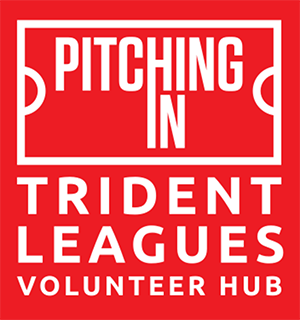
Most clubs are looking for volunteers. Find out more on the button below:
www.PitchingInVolunteers.co.ukAll the news and results in one place.
REGISTER